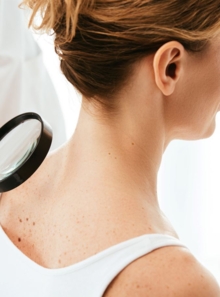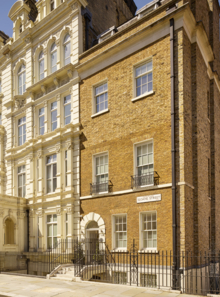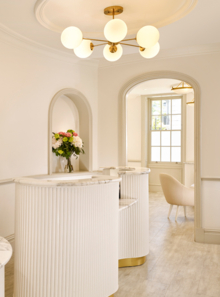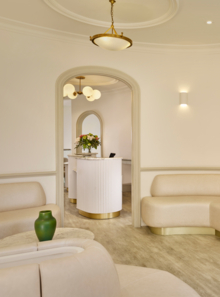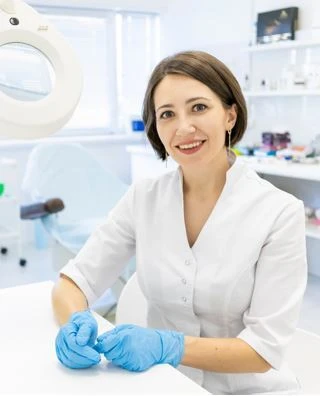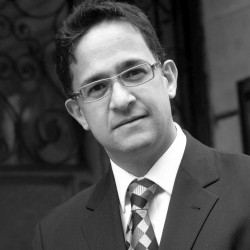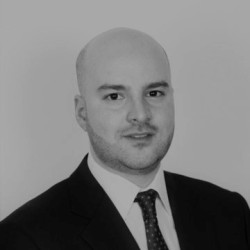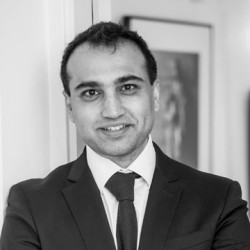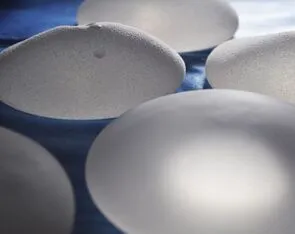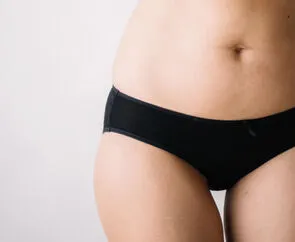Medically Reviewed January 2024,
by Dr. Susan Mayou (GMC: 2405092) - founder of the Cadogan Clinic and one of the world's leading dermatologists
What is Mohs Surgery?
Mohs surgery is performed by removing successive thin layers of cancerous skin and examining each layer under a microscope – right there and then in the theatre - until only cancer-free skin tissue is left.
Today, Mohs surgery has come to be accepted as the most effective technique for removing the most common types of skin cancer.
The benefit of Mohs surgery is that it is able to preserve the greatest amount of healthy tissue around the cancer, while also completely removing all dangerous cancer cells. Mohs Surgery also allows your surgeon to verify that all cancer cells have been removed during the procedure, increasing the likelihood of a full cure and reducing the likelihood of further surgery.
Efficient, cost-effective treatment
- Single visit outpatient surgery
- Local anaesthesia
- Lab work done on-site
- Low recurrence rate
Precise results
- Surgeon examines 100% of cancer margins
- Spares healthy tissue
- Leaves smallest scar possible
Highest Cure Rate
- 99% for newly treated skin cancer
- 95% for recurring skin cancer from previous treatment
Mohs surgery is, therefore, an excellent treatment for skin cancers that have a risk of reoccurrence, are in more sensitive areas such as the eyes, nose, ears, hands, feet and genitals, or for more aggressive forms of skin cancer.
Cadogan Clinic is one of just a handful of specialist skin cancer facilities with the capability to perform Mohs micrographic surgery in London.
Get in touch
Why do people have it?
Mohs surgery is considered the very best technique for the safe and effective removal of non-melanoma skin cancer:
- Results in a smaller scar than traditional excision
- Gives immediate confidence that the skin cancer has been removed
- Produces the highest skin cancer cure rate of 99%
- Has the lowest recurrence rate and is cost-effective
Who is suitable?
Mohs surgery is generally regarded as the best technique to remove non-melanoma skin cancer and is generally recommended in all complex or high-risk cases.
These may include:
- Skin cancers that have a risk of reoccurrence
- Skin cancers in more sensitive areas such as the eyes, nose, ears, hands, feet and genitals
- More aggressive forms of skin cancer that require immediate, precise excision
- Large skin cancers in low-risk areas (to reduce the scale of wound area)
- Skin cancers with difficult-to-see borders
For small or superficial low-risk cancers in areas such as the abdomen, chest, back, arms and legs, standard techniques such as traditional surgical excision, cryotherapy or photodynamic therapy can provide adequate treatment.
For melanoma skin cancers it is important to leave a wide margin around the skin cancer site, so Mohs surgery is not appropriate.
What does it involve?
The visible skin cancer is outlined with a marker pen by your surgeon and the area is numbed with local anaesthetic; you will be awake during the procedure.
The cancer is then surgically removed with a very fine margin of healthy skin around and underneath it. A map of the surgical site and the sections of removed tissue is drawn by the surgeon so he can understand exactly how the excised tissue maps to the wound site. If further excision is required, the corresponding area can be easily identified.
The excised tissue is then examined under a microscope to assess whether any skin cancer remains. It can take up to an hour for your technician to assess this, and meanwhile you will be asked to wait with a dressing over the wound site.
If cancerous tissue is observed in the skin examined under the microscope, a further layer will be removed from the corresponding area on the wound.
The surgeon will know exactly where to find the remaining tumour from the map drawn of the location of tumour. It may be necessary to inject more local anaesthetic before further surgery.
This process is repeated as many times as is necessary until there is no cancer remaining. Sometimes the tumour can be much larger than is visible at first on the surface of the skin, so it is only via this iterative process that comprehensive excision can be assured.
That said, approximately 80% of patients will only need to have one layer of skin removed to remove the cancerous tissue.
This is performed as an outpatient procedure, and you will be able to head home the same day knowing that all cancerous cells have been removed.

How does Mohs Surgery differ from traditional Skin Cancer Removal techniques?
During Mohs micrographic surgery the skin cancer is removed one thin layer at a time and then immediately assessed under a microscope (either by the surgeon or a pathologist), enabling an exceptionally precise surgical excision of the skin cancer.
This process reduces the margin of healthy skin surrounding the cancerous area that is also removed during surgery, reducing the size of the wound and scar site. Your surgeon can also be certain 100% certain that the skin cancer has been fully removed on the day of the procedure.
By contrast, traditional skin cancer removal techniques involve a less precise approach, often meaning that a more sizeable area of healthy unaffected skin is removed along with the cancerous area. Alternatively, if too little is removed, a second procedure is required. It will also not be until the results from the histopathology have been received, that you will know for certain that your skin cancer has been fully removed.
Mohs Surgery Specialists
We have invited a selection of the country's very best consultants to join us at the Cadogan Clinic so that you can be sure that whatever the nature of your treatment, you will be seeing one of the top practitioners in the country.
Cadogan Clinic. A strong tradition of innovation

Founded in 2004 by world renown dermatologist Dr Susan Mayou, we now work with over 100 leading consultants and successfully treat over 20,000 patients each year. We have been winning industry awards since inception.
Get in touch
Frequently Asked Questions
How can I reduce my risk of skin cancer?
There are many ways that you can reduce your risk of skin cancer.
- Limit your exposure to UV radiation
- Use broad-spectrum sunblock when exposed to the sun. Broad spectrum will help protect against both UVA and UVB rays
- Use a minimum of SPF 30 in your sunblock, ensure the UVA protection is adequate as denoted by UVA and apply thickly and frequently
- Avoid the use of sunbeds (Using sunbeds for the first time below the age of 35 increases the risk of developing melanoma by nearly 60%
- Perform a monthly skin self-examination looking for ABCDE of moles
ABCDE Checklist for suspicious features:
- Asymmetry: Moles that are an irregular shape and have two different halves.
- Border: Moles with a ragged border.
- Colours: Moles that have a mix of two or more colours.
- Diameter: Moles that are larger than 6mm (1/4 inch) diameter.
- Evolution: A mole which has changed in size or shape over time.
When performing your monthly skin checks ensure you are doing it after a bath or shower, in a well-lit room, with the aid of a full-length mirror looking for any changes in moles thoroughly.
You can also self-assess yourself for risk of melanoma. The Melanoma Risk Factor Assessment checklist can tell you if you would benefit from a mole check by a dermatologist, or from more regular self-examinations.
The Melanoma Risk Factor Assessment:
- Have you ever been sunburnt badly?
- Does your skin burn first and then tan? Do you tan at all?
- Do you have any outdoor hobbies?
- Have you ever used sunbeds?
- Have you ever lived anywhere abroad that was very hot/sunny?
- Have you ever had a job where you worked outdoors?
- Has anyone in your family ever had melanoma?
- Do you wear sunblock when exposed to the sun?
If you notice any changes to a mole or a patch of skin, it is important to seek the advice of your GP or a dermatologist as soon as possible. If your regular GP has any concerns about the changes in your moles, they will refer you to a consultant dermatologist for further examination.
A dermatologist will perform a full skin examination to check all of your moles. If the dermatologist has any concerns about any unusual moles or patches of skin, they will either go on to remove (excise) the mole or take a sample of a suspicious patch of skin (biopsy) to send in for analysis.
It is important to note that not all changes to moles are the results of skin cancer. It is normal for moles to change in size, number or appearance over time, even some disappearing entirely. Hormonal changes, like those that occur with puberty or pregnancy, can also cause moles to increase in number or to become darker.
Why is it called 'Mohs' surgery?
Mohs micrographic surgery is named after the doctor who developed the technique, Dr Frederic Mohs.
Who performs Mohs micrographic surgery?
Mohs surgery is a combination of several specialised stages, and requires the complementary skills of a team of qualified professionals — a dermatologist, nursing staff, histo-technicians and sometime plastic or oculoplastic surgeons.
Only dermatologists or dermatological surgeons who are specially trained in Mohs micrographic surgery can perform this procedure. This training is additional to that required to become a general dermatologist.
Occasionally, support may be given by other specialists, e.g. a plastic surgeon to reconstruct the wound site, or to provide a skin graft or flap in more complex cases.
Cadogan Clinic is able to provide all of these skillsets to our Mohs patients, and the entire process takes place on-site in our theatres and recovery suite. Your consultation, Mohs surgery, reconstruction and follow-up are all done in the specialist unit courtesy of our multidisciplinary team.
All surgery must be performed in a proper operating theatre with appropriate air changes and nursing staff. Most procedures are performed under local anaesthetic, but general anaesthesia can be made available.
How long does Mohs treatment take?
Mohs surgery is a complex process and can take as long as 3 – 4 hours, depending on the complexity of the cancer in question.
Removing the tissue and analysing it – often more than once - can take up to one or two hours, whilst the reconstruction of the site following the removal of the cancer can also take a similar amount of time.
What happens during Mohs surgery?
The procedure is performed under local anaesthesia and involves three basic steps:
- Surgical removal of tissue
- Interpretation of tissue under the microscope
- Removal and analysis of further layers of cancer if required, or reconstruction of the wound site
Who is suitable for Mohs micrographic surgery?
Mohs micrographic surgery is suitable for complex or high risk non-melanoma skin cancer removal.
It is particularly useful for:
- Skin cancer in an important cosmetic or functional area such as the eyelids, nose, ears, lips, genitals and hands, where it is preferable to remove as little healthy surrounding skin as possible
- Skin cancer that has been treated in the past and has returned or recurred
- Skin cancer where there has been previous surgery or radiotherapy on the treatment area
- Skin cancer where scar tissue exists in the vicinity of the treatment area
- Skin cancer with poorly defined edges, and where the tumour type is shown to be infiltrative
- Skin cancer that is growing rapidly
- Very large skin cancers where a minimised wound area is preferred
How long will I need to stay in hospital?
Mohs surgery is typically complete in a matter of hours, after which you will be discharged home.
You can expect to spend a full morning or afternoon at the Clinic at the very most.
How effective is Mohs surgery?
Mohs surgery has the highest cure rate for both new (up to 99%) and recurrent tumours (95%).
Traditional surgical methods have a cure rate of around 90%.
What risks are associated with Mohs surgery?
Whilst the risks of Mohs surgery are minimal, all surgical procedures do carry some risk.
Risks can include:
- Bleeding/bruising.
- Infection
- Minor nerve damage, or numbness
Are there alternative treatments to Mohs surgery?
Yes, traditional surgical skin cancer removal or radiotherapy may be preferred. Your doctor will outline the preferred option at your initial consultation.
How successful is Mohs surgery?
Mohs surgery is highly successful, and results are as high as 99 percent for the removal of a basal cell skin cancer and 95 percent for squamous cell skin cancer and other recurrent cancers.
Mohs Surgery is very accurate – your surgeon will be removing the skin layer by layer off the cancer site. The surgeon will then examine each layer under a microscope to determine if any cancer cells remain in the tissue. The process of removal and inspection under the microscope is repeated until all cancer cell tissue has been removed.
Mohs surgery has better long term cosmetic results - through this method, the surgeon can remove the entire cancer tissue without damaging the surrounding healthy skin tissue. This process keeps the scarring minimal and promotes quicker healing. Approximately 80% of patients will only need to have one layer of skin removed to remove the cancerous tissue. As the recurrence rate is lower than any other technique Mohs can overall give the best long term cosmetic result.
Is Mohs surgery painful?
Mohs surgery is largely pain-free. Aside from the initial injection of anaesthetic to numb the area, patients will feel very little pain either during of after the surgery.
Most patients experience no pain at all during or after the procedure. If minor pain is experienced, this can usually be handled with paracetamol or an over the counter pain medicine.
Will I have a scar after Mohs surgery?
Mohs surgery will preserve as much healthy skin as possible and once the cancer is removed, your doctor or surgeon will ensure reconstruction to the area leaves as minimal scarring as possible.
Any scarring will improve over time but can take around a year to completely heal.
Scar injections and other treatments such as laser resurfacing are also available at Cadogan Clinic so we can provide you with an entire portfolio of treatments around your Mohs procedure.
What aftercare will I need following Mohs surgery?
Your doctor or surgeon will advise you on aftercare at your consultation and again immediately after your surgery.
You will be asked to return to the Clinic following your reconstruction to ensure your healing is progressing as planned.
Your dermatologist plays an important role in helping you to maintain cancer - free skin so regular check-ups can be arranged for the future.
How To Find Us
The Cadogan Clinic is based at 120 Sloane Street in Chelsea, just off Sloane Square and the Kings Road.
We are accessible by all major bus routes that pass through Sloane Square and Sloane Street, as well as Sloane Square tube station.
We are just a 5 minute walk northwards up Sloane Street once you have arrived at Sloane Square.
Local pay parking is available just around the corner from the Clinic on Cadogan Gate, Cadogan Square and Cadogan Gardens. Our local residential parking zone is the Royal Borough of Kensington & Chelsea.
Address: 120 Sloane Street, Chelsea, London, SW1X 9BW



